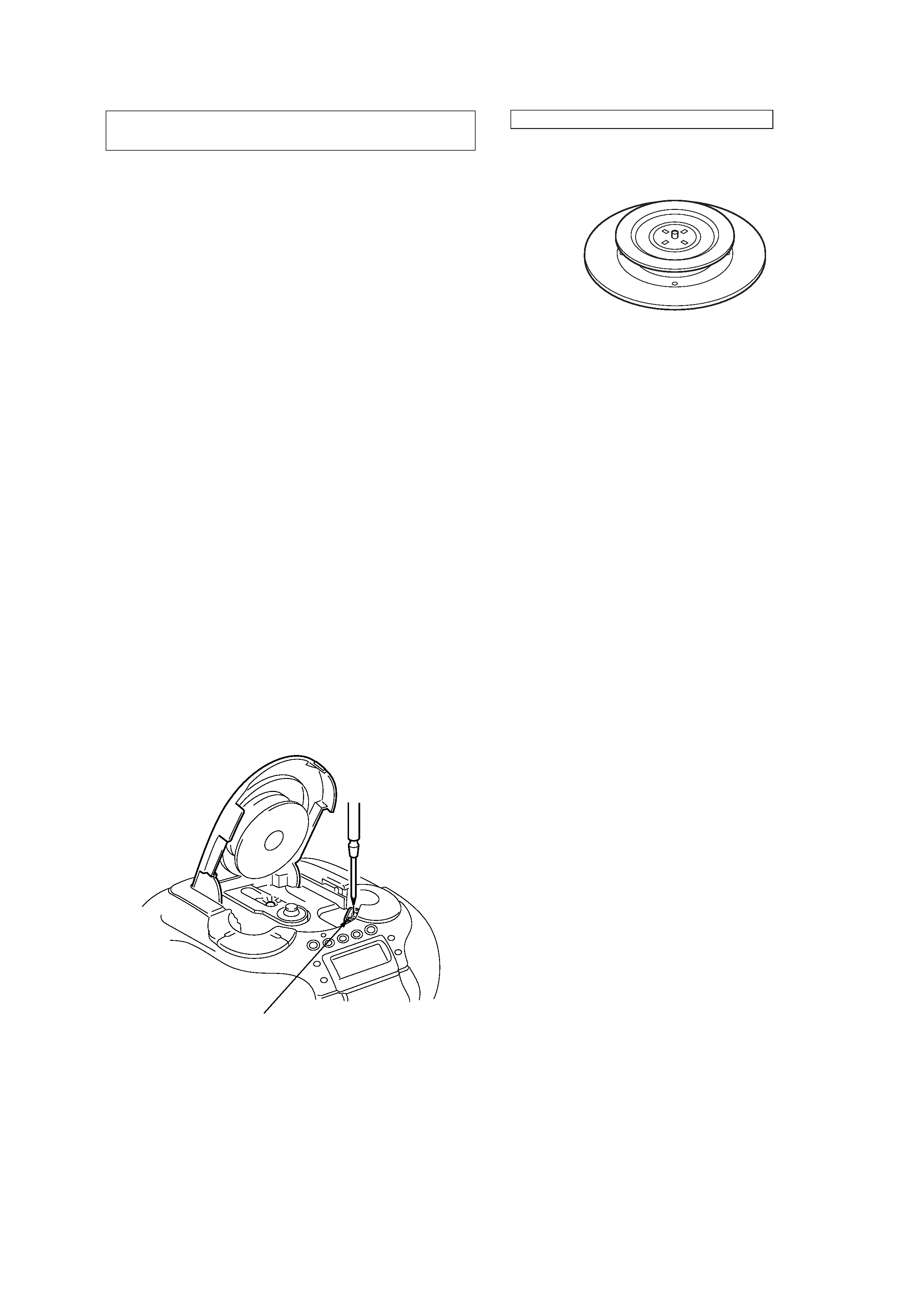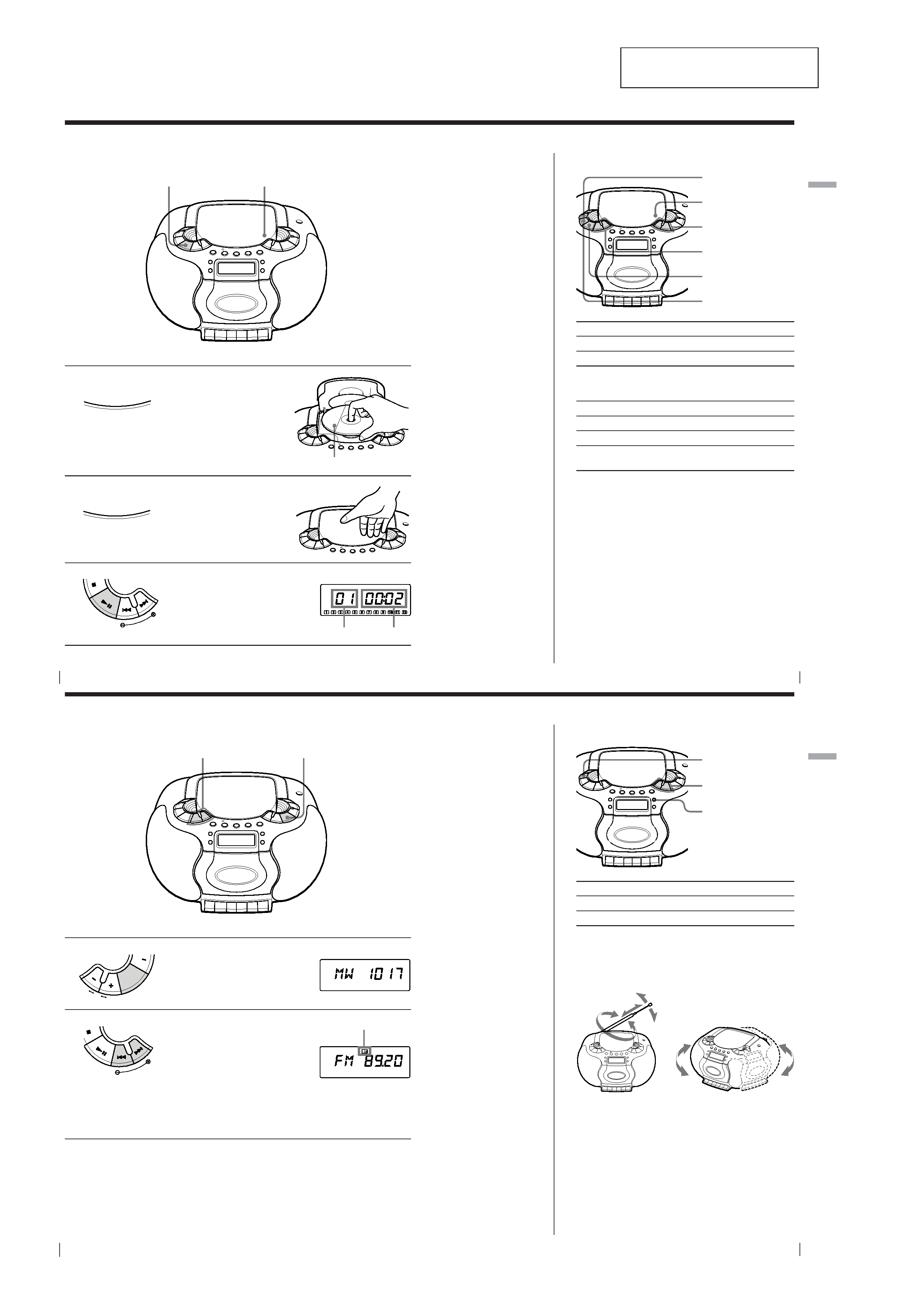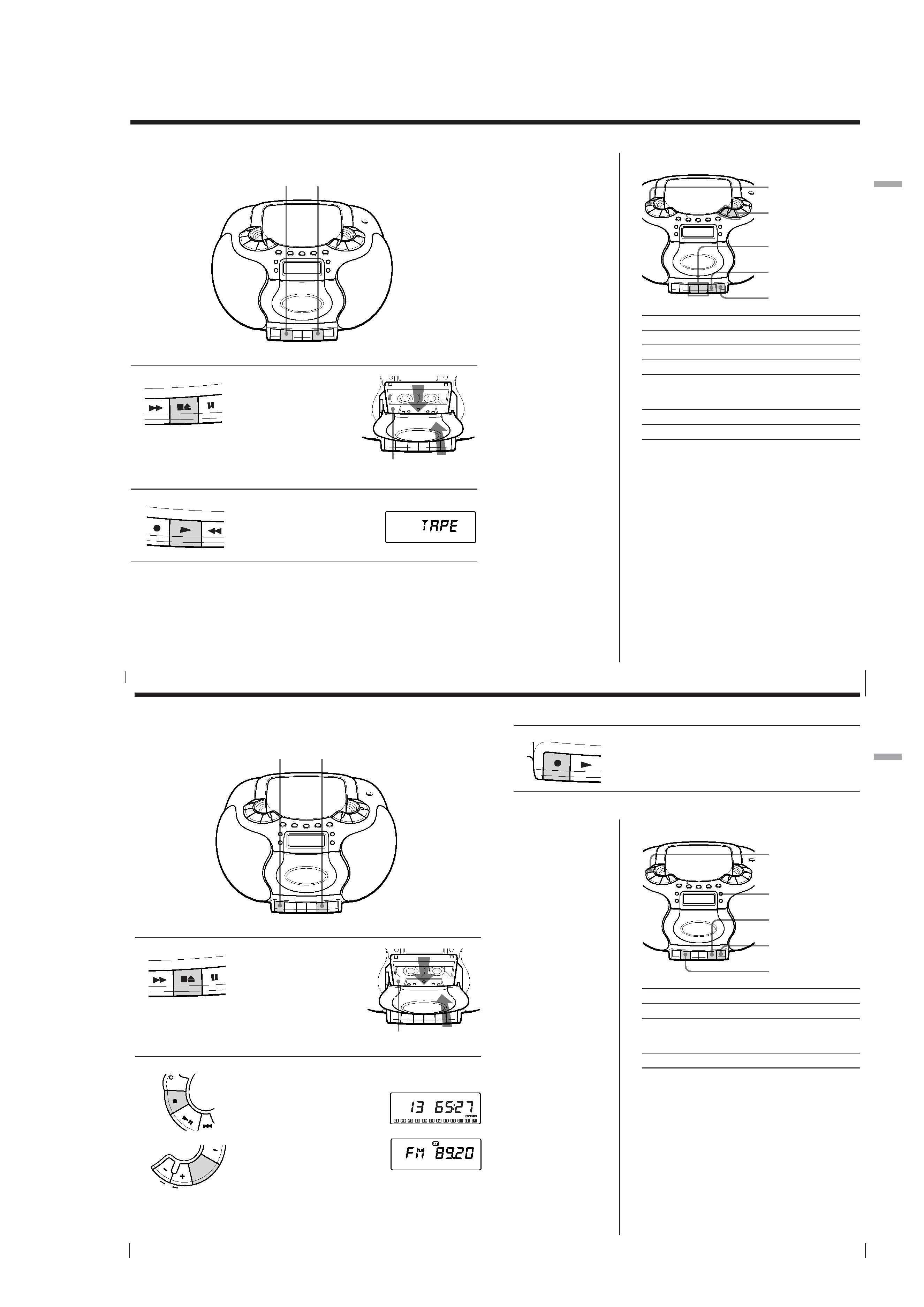
MICROFILM
SERVICE MANUAL
CD RADIO CASSETTE-CORDER
AEP Model
UK Model
SPECIFICATIONS
CFD-E55L
CD
Model Name Using Similar Mechanism
CFD-Z500
Section
CD Mechanism Type
KSM-213CDM
Optical Pick-up Name
KSS-213C
TAPE
Model Name Using Similar Mechanism
CFD-Z500
Section
Tape Transport Mechanism Type
MF-Z500-117
IF
FM: 10.7 MHz
MW/LW: 450 kHz
Aerials
FM: Telescopic aerial
MW/LW: Built-in ferrite bar aerial
Cassette-corder section
Recording system
4-track 2 channel stereo
Fast winding time
Approx. 120 sec. with Sony cassette C-60
Frequency response
TYPE I (normal): 70 - 13,000 Hz
General
Speaker
Full range: 8 cm (3 1/4 in.) dia.,
3.2 ohms, cone type (2)
Outputs
Headphones jack (stereo minijack)
For 16 - 68 ohms impedance headphones
Maximum power output
2 W + 2 W
Power requirements
For CD radio cassette-corder:
230 V AC, 50 Hz
9 V DC, 6 R20 (size D) batteries
For memory back-up:
4.5 V DC, 3 R6 (size AA) batteries
CD playersection
System
Compact disc digital audio system
Laser diode properties
Material: GaAlAs
Wave length: 780 nm
Emission duration: Continuous
Laser output: Less than 44.6
µW
(This output is the value measured at a distance of
about 200 mm from the objective lens surface on
the optical pick-up block with 7 mm aperture.)
Spindle speed
200 r/min (rpm) to 500 r/min (rpm) (CLV)
Number of channels
2
Frequency response
20 - 20,000 Hz +0/0.5 dB
Wow and flutter
Below measurable limit
Radio section
Frequency range
FM
87.5 - 108 MHz
MW
531 - 1,611 kHz
LW
153 - 279 kHz
Power consumption
AC 17 W
Battery life
For CD radio cassette-corder:
FM recording
Sony manganese SUM-1 (N): approx. 9 h
Sony alkaline AM-1 (N): approx. 19 h
Tape playback
Sony manganese SUM-1 (N): approx. 5 h
Sony alkaline AM-1 (N): approx. 14 h
CD playback
Sony manganese SUM-1 (N): approx. 1.5 h
Sony alkaline AM-1 (N) : approx. 7 h
Dimensions
Approx. 304
× 169 × 262 mm (w/h/d)
(12
× 6 3/4 × 10 3/8 inches) (incl. projecting parts)
Mass
Approx. 3.6 kg (7 lb. 15 oz) (incl. batteries)
Supplied accessories
AC power cord (1)
Design and specifications are subject to change
without notice.
Ver 1.0 1999. 11

2
SAFETY-RELATED COMPONENT WARNING!!
COMPONENTS IDENTIFIED BY MARK 0 OR DOTTED
LINE WITH MARK 0 ON THE SCHEMATIC DIAGRAMS
AND IN THE PARTS LIST ARE CRITICAL TO SAFE
OPERATION. REPLACE THESE COMPONENTS WITH
SONY PARTS WHOSE PART NUMBERS APPEAR AS
SHOWN IN THIS MANUAL OR IN SUPPLEMENTS PUB-
LISHED BY SONY.
CAUTION
Use of controls or adjustments or performance of procedures
other than those specified herein may result in hazardous ra-
diation exposure.
1.
SERVICING NOTES ..............................................
3
2.
GENERAL ..................................................................
4
3.
DISASSEMBLY ........................................................
7
4.
MECHANICAL ADJUSTMENTS ...................... 12
5.
ELECTRICAL ADJUSTMENTS
Tape Deck Section ......................................................... 12
Tuner Section ................................................................. 13
CD Section ..................................................................... 15
6.
DIAGRAMS
6-1. Block Diagram CD Section .................................... 17
6-2
Block Diagram TUNER Section ............................ 19
6-3. Block Diagram MAIN Section ............................... 21
6-4. Block Diagram POWER SUPPLY Section ............ 23
6-5. Printed Wiring Boards CD Section ........................ 27
6-6. Schematic Diagram CD Section ............................. 29
6-7. Printed Wiring Boards
MAIN/POWER SUPPLY Section ........................... 32
6-8. Schematic Diagram MAIN (TUNER) Section ...... 35
6-9. Schematic Diagram
MAIN (AUDIO)/POWER SUPPLY Section .......... 40
6-10. IC Pin Function Description .......................................... 43
6-11. Printed Wiring Boards DISPLAY Section ............. 45
6-12. Schematic Diagram DISPLAY Section .................. 47
7.
EXPLODED VIEWS ............................................... 54
8.
ELECTRICAL PARTS LIST .............................. 61
This appliance is classified as a CLASS 1 LASER product.
The CLASS 1 LASER PRODUCT MARKING is located on
the rear exterior.
Laser component in this product is capable of emitting radiation
exceeding the limit for Class 1.

3
SECTION 1
SERVICING NOTES
CHUCK PLATE JIG ON REPAIRING
On repairing CD section, playing a disc without the CD lid, use
Chuck Plate Jig.
· Code number of Chuck Plate Jig: X-4918-255-1
The laser diode in the optical pick-up block may suffer electro-
static break-down because of the potential difference generated
by the charged electrostatic load, etc. on clothing and the human
body.
During repair, pay attention to electrostatic break-down and also
use the procedure in the printed matter which is included in the
repair parts.
The flexible board is easily damaged and should be handled with
care.
NOTES ON LASER DIODE EMISSION CHECK
The laser beam on this model is concentrated so as to be focused
on the disc reflective surface by the objective lens in the optical
pick-up block. Therefore, when checking the laser diode emis-
sion, observe from more than 30 cm away from the objective lens.
Notes on chip component replacement
· Never reuse a disconnected chip component.
· Notice that the minus side of a tantalum capacitor may be dam-
aged by heat.
LASER DIODE AND FOCUS SEARCH OPERATION
CHECK
1. Turn POWER switch on with no disc inserted and make Func-
tion switch to CD position.
2. Open the lid for CD.
3. Turn on S701 as following figure.
4. Press the u button.
5. Confirm the laser diode emission while observing the object-
ing lens. When there is no emission, Auto Power Control cir-
cuit or Optical Pick-up is broken.
Objective lens moves up and down three times for the focus
search.
NOTES ON HANDLING THE OPTICAL PICK-UP
BLOCK OR BASE UNIT
S701

4
SECTION 2
GENERAL
This section is extracted from
instruction manual.
Basic Operations
4
GB
Playing a CD
Basic Operations
Display
Playing time
Track number
With the label side up
3
1, 2
Connect the supplied AC power cord (see page 26).
1
Press ZPUSH OPEN/CLOSE
down to open the CD
compartment and place the CD
on the CD compartment.
2
Close the lid of the CD
compartment.
3
Press u.
The player turns on (direct
power-on) and plays all the tracks
once.
OPEN/ CLOSE
Z PUSH
OPEN/ CLOSE
Z PUSH
TUNE
TIM
E S
ET
Basic Operations
Basic
Operations
5
GB
Use these buttons for additional operations
To
Press
adjust the volume
VOL +,
stop playback
x
pause playback
u
Press the button again to
resume play after pause.
go to the next track
>
go back to the previous track
.
remove the CD
Z
PUSH OPEN/CLOSE
turn on/off the player
OPERATE
(or POWER, see page 2)
Tip
Next time you want to
listen to a CD, just press
u
. The player turns on
automatically and starts
playing the CD.
OPERATE
x
u
.
, >
VOL , +
Z
PUSH
OPEN/CLOSE
Basic Operations
6
GB
Listening to the radio
Connect the supplied AC power cord (see page 26).
1
Press RADIO BAND until the
band you want appears in the
display (direct power-on).
2
Hold down TUNE TIME SET + or
until the frequency digits begin
to change in the display.
The player automatically scans
the radio frequencies and stops
when it finds a clear station.
If you can't tune in a station,
press the button repeatedly to
change the frequency step by
step.
Display
Indicates an FM stereo
broadcast
1
2
BA
N
D
RA
D
IO
VO
L
TUNE
TIM
E S
ET
Basic Operations
Basic
Operations
7
GB
Use these buttons for additional operations
To
Press
adjust the volume
VOL +,
turn on/off the radio
OPERATE
To improve broadcast reception
Reorient the antenna for FM. Reorient the player itself
for MW/LW.
for FM
for MW/LW
Tips
· If the FM broadcast is
noisy, press PLAY
MODE ·MONO/ST ISS
until "Mono" appears in
the display and the
radio will play in
monaural.
· Next time you want to
listen to the radio, just
press RADIO BAND.
The player turns on
automatically and starts
playing the previous
station.
OPERATE
VOL , +
PLAY MODE
MONO/ST ISS

5
Basic Operations
8
GB
Playing a tape
Connect the supplied AC power cord (see page 26).
1
Press xZ to open the tape
compartment and insert a
recorded tape. Use TYPE I
(normal) tape only. Close the
compartment.
2
Press N.
The player turns on (direct
power-on) and starts playing.
With the side you want
to play facing you
Display
1
2
STOP/EJECT
PLAY
Basic Operations
Basic
Operations
9
GB
Use these buttons for additional operations
To
Press
adjust the volume
VOL +,
stop playback
xZ
fast-forward or rewind the tape M or m
pause playback
X
Press the button again to
resume play after pause.
eject the cassette
xZ
turn on/off the player
OPERATE
Tip
Next time you want to
listen to a tape, just
press N. The player
turns on automatically
and starts playing the
tape.
xZ
X
m
, M
OPERATE
VOL , +
Basic Operations
10
GB
Recording on a tape
Connect the supplied AC power cord (see page 26).
1
Press xZ to open the tape
compartment and insert a blank
tape. Use TYPE I (normal) tape
only.
2
Select the program source you
want to record.
To record from the CD player,
insert a CD (see page 4) and press
x
on the CD section.
To record from the radio, tune in
the station you want (see page 6).
31
With the side you want to
record on facing you
Display
STOP/EJECT
OPERA
TE
OPR/BA
TT
BA
N
D
RA
D
IO
VO
L
Basic Operations
Basic
Operations
11
GB
3
Press z to start recording
(N is depressed automatically).
Use these buttons for additional operations
Tips
· Adjusting the volume or
the audio emphasis (see
page 28) will not affect
the recording level.
· If the MW/LW program
makes a whistling
sound after you've
pressed z in step 3,
press PLAY MODE·
MONO/ST ISS
(Interference Suppress
switch) repeatedly until
the noise is at a
minimum.
· For the best results, use
the AC power as a
power source.
· To erase a recording,
proceed as follows:
1 Insert the tape whose
recording you want to
erase.
2 Press X.
3 Press N.
4 Press z.
5 Press X.
To
Press
stop recording
xZ
pause recording
X
Press the button again to
resume recording.
turn on/off the player
OPERATE
xZ
X
OPERATE
PLAY MODE
MONO/ST ISS
N
REC
